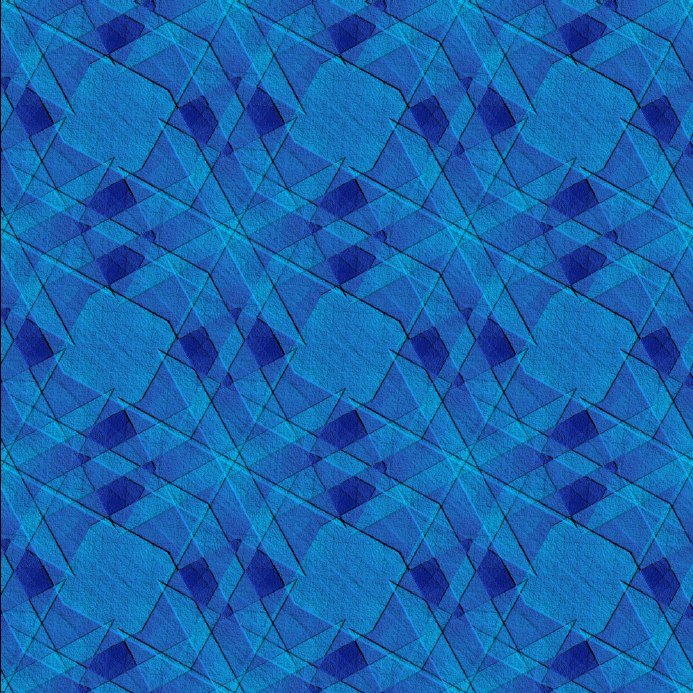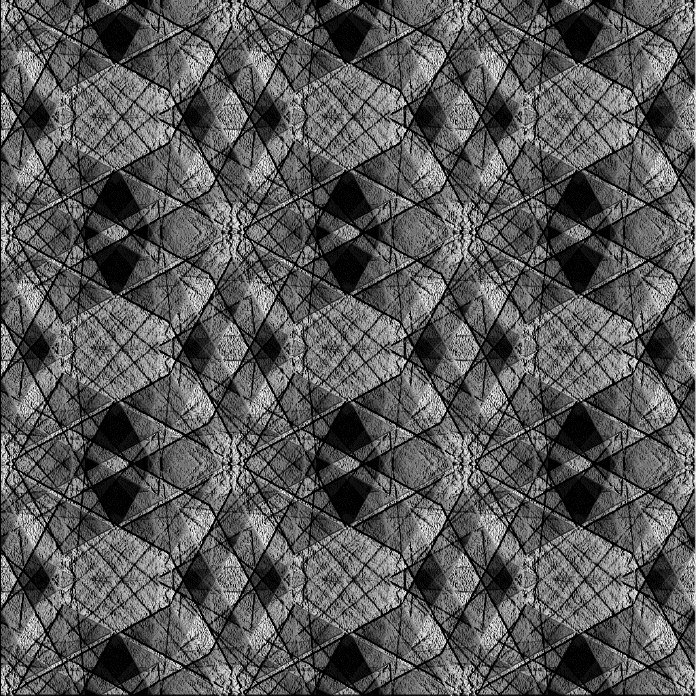|
The art and science of symmetric design Michael Field Department of Mathematics
Abstract We describe some of the issues - both philosophical and technical - involved in the evolution of computer software used for the design and realization of aesthetically appealing symmetric patterns. We illustrate how the choice of algorithm can dramatically affect the final design.
The images shown in this paper1 were all designed and constructed using a software package called prism (an acronym for PRograms for the Interactive Study of Maps) that I started to develop about eleven years ago. In recent years I have used prism as the basis for a course on `Patterns, Designs and Symmetry' that I teach to Junior/Senior level art students at the University of Houston, and also in a seminar for teachers held under the auspices of the Houston Teachers Institute. These teaching experiences, and the possibilities for using this computer software in the classroom, are described in more detail in [4,5]. Although working with prism in a teaching situation has often provided a strong stimulus to make the interface more user friendly, the main impetus for developing prism has always been my personal interest in finding new and effective ways to design, color and realize attractive symmetric patterns. In this article, I want to share some speculations and experiences generated by recent attempts to produce `art' from silicon and chaos. All of the images that are shown result from an ongoing project to develop a library of algorithms for the design and artistic realization of the one- and two-color wallpaper patterns. Throughout, we shall follow the standard notational conventions
for wallpaper patterns as described, for example, in Washburn and Crowe
[9]. We refer to [1,7]
for general background on symmetry and the use of methods from chaos and
dynamical systems in design. For 2-color designs, see [1,2,6].
Many colored images can be found at the URL: nothung.math.uh.edu/~mike/.
The references [8,9] provide an excellent
source of many examples of symmetric designs and patterns from many cultures
and eras.

Figure 1: A two-color wallpaper design of type p6 '
In Figure 1, we show a characteristic wallpaper pattern designed using prism . I feel that the development of the program that led to the creation of this image as an integral part of the creative process. That is, the mathematical algorithms, the computer program, and the design and reproduction (realization) of the images are just different facets of the same underlying process. In this regard, I am not so interested in creating pictures using a generic graphics software package. For me, the process of creation and design involves developing the tools and techniques in parallel with their application. Indeed, the development of these tools is largely governed by the character of the image I want to design and the way in which I want to realize the final image (for example, on photographic paper). Of course, sculptors and artists have always developed their own technology - whether it be pigments or the engineering and machining of contemporary sculpture. In spite of the apparent demise of the Renaissance man and the increasing compartmentalization of knowledge, I believe a creative artist - or scientist - cannot be detached from the tools with which he works. Sometimes, he or she needs to be an engineer or computer programmer. In the following sections, we show some of effects that we can achieve with different types of algorithm. Partly for reasons of space, we avoid any detailed description of the explicit mathematical form of the algorithm (but see [4,7]).
2. Algorithms for symmetric design: I
Let us start with a hypothetical situation. Suppose that a designer wants to create a wallpaper pattern based on lions. What type of algorithm should be used? Is it possible to design a `lion algorithm' that will reliably produce `lion-like' images and which can be adjusted to vary the shape and textures of the lion? What type of symmetry should the designer use to convey, for example, a sense of motion or speed? In one sense it is relatively straightforward to implement a lion algorithm. Take a scanned image of a lion and symmetrize over the appropriate symmetry group. This is the kaleidoscopic method employed so effectively in Kevin Lee's KaleidoMania! program. However, symmetric images produced by symmetrization techniques typically lack global coherence. More precisely, the process of symmetrization typically introduces discontinuities in the image - unless one avoid overlaps (see [4]). This, of course, is not a criticism of the kaleidoscopic method. Rather, it an observation that to create artistically satisfying images one needs more than a kaleidescope. Although our approach has not yet led to a simple recipe
for producing a `lion algorithm', one class of algorithms we have experimented
with can lead to images with a pronounced naturalistic flavor. In Figure
2 we show one such pattern that would resonate with any visitor to
the Australian outback.

Figure 2: Fly Quilt
The quilt shown in Figure 2 is a wallpaper
pattern of type cm and was constructed using ideas based on iterated
function systems. In particular, the algorithm used was non-deterministic.
The choice of symmetry cm is apposite as this pattern has just one
direction of symmetry. We might also have used the symmetry pm -
then the flies would have lined up wing-tip to wing-tip. The generating
function used was a polynomial map in two variables. By making small changes
in the coefficients of the generating function, it is easy to make incremental
changes in the shape of the flies. We show one possible evolutionary sequence
in Figure 3.

Figure 3: Evolving flies
3. Algorithms for symmetric design: II
In another direction, we have developed algorithms that
can generate abstract angular patterns. In Figure 4,
we show two examples of these patterns. The pattern on the left is of type
p4, that on the right of type pmm. Both patterns were produced
using a non-deterministic algorithm and used the same continuous piecewise
linear generating function. However, when we attempt to color this type
of image, we find that there are drawbacks to using a non-deterministic
algorithm. The reason for this is somewhat technical to explain but is
related to the fact that the associated invariant measures (see [4])
are often rather uniform. This can make effective coloring quite difficult2.
This problem is less severe when we use a deterministic algorithm.
Initial investigations of piecewise linear deterministic algorithms with
symmetry p4m have resulted in a number of quite promising angular
designs and we hope to report on these elsewhere.

Figure 4: Abstract designs of types p4 and pmm
Although non-deterministic algorithms we have experimented
with often produce images with a lack of fine detail or edge data, they
can yield images with rich textures. In Figure 5, we show an example of
a 2-color wallpaper pattern of type p'cgg
produced using a non-deterministic algorithm.

Figure 5: Two-color design of pc 'gg
4. Algorithms for symmetric design: III
Although it is relatively easy to construct quilt patterns
using methods based on iterated function systems, there is no doubt that
the most aesthetically pleasing patterns are generated using deterministic
algorithms associated to (trigonometric) polynomial mappings. In part this
is because deterministic algorithms of this type generally lead to images
with sharply defined edges. In addition, there is usually an abundance
of fine structure in the image - often highly localized. Experimentation
with the algorithm, symmetry and coloring, leads to a symmetrically related
set of curves associated to the singular set of the mapping. In Figure
6 we shown an image of type pm that was constructed using a
deterministic algorithm. The symmetry type pm is well adapted to
giving a sense of direction and motion to the image - in this case from
left to right.

Figure 6: A wallpaper pattern of type pm 
Figure 7: A wallpaper pattern of type cmm
In Figure 7, we show a deterministic quilt pattern of type cmm. The design of wallpaper patterns offers additional challenges.
It is well known that some symmetry types seem much more attractive than
others. Further, there appears to be a cultural bias in our response to
symmetry. (We refer the reader to [9] for a more extensive
discussion of cultural and psychological responses to different types of
symmetry.) In Western culture, designs with symmetry p4m (square
tiling) or p6m (hexagonal tiling) are ubiquitous. On the other hand,
patterns of type pgg are rather rare. One can speculate that it
is the absence of reflection symmetry in pgg patterns that is responsible
for their lack of appeal. However, patterns of type pg - also without
reflection symmetry - are quite common. Generally, we have been somewhat
unsuccessful in designing attractive patterns of type pgg using
non-deterministic algorithms. We have had more success using deterministic
algorithms - indeed, the search for algorithms that would yield appealing
versions of patterns of type pgg was one of the reasons for our
implementation of deterministic algorithms for all the 1- and 2-color quilt
patterns. In Figure 8, we show an example of a two-color
quilt pattern of type pg'g'
designed using a deterministic algorithm.

Figure 8: A 2-color wallpaper pattern of type pg 'g '
In Figures 9 we show an example of a
2-color quilt of type p6'
constructed using a deterministic algorithm.

Figure 9: A 2-color wallpaper pattern of type p6 '
Our last picture is of a wallpaper pattern of type pmm
constructed using a deterministic algorithm. The printed version of this
image was exhibited in Granada as part of The Frontier between Art and
Science, International Exhibition.

Figure 10: A wallpaper pattern of type pmm
5. Conclusions
Perhaps the main criticism levelled against those who
create art using computer graphics or other modern technology is that somehow
what is done is not art. My own view is that creative artists are often
innovative engineers who develop their chosen medium (I do not claim the
converse). Thinking about computer graphics and art in this way leads to
many intriguing and challenging problems. In art, technology and science.
Plus
ça change, c'est le même chose.
References
Footnotes:1 The original version of this article was prepared for, and appeared in, the proceedings of the Bridges 2000 meeting [3]. As images were restricted to greyscale, the emphasis in the article was on algorithms for one -color designs rather than on coloring algorithms for 2-color designs. This version of this article was specially prepared for the on-line journal VisMath and includes colored images, including two-color designs.2 In this case
we have given the images a `3D' effect using the embossing option of the
gimp software package.
|
